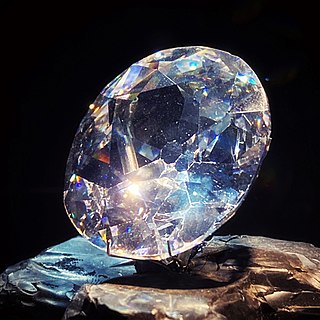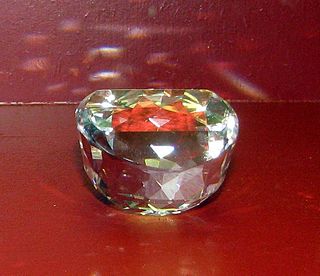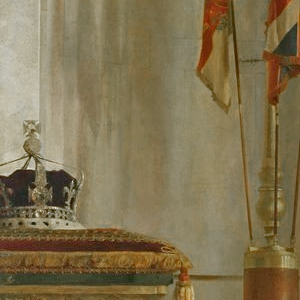
The Koh-i-Noor, also spelt Koh-e-Noor, Kohinoor and Koh-i-Nur, is one of the largest cut diamonds in the world, weighing 105.6 carats (21.12 g). It is part of the Crown Jewels of the United Kingdom. The diamond is currently set in the Crown of Queen Elizabeth The Queen Mother.

The Cullinan Diamond is the largest gem-quality rough diamond ever found, weighing 3,106 carats (621.20 g), discovered at the Premier No.2 mine in Cullinan, South Africa, on 26 January 1905. It was named after Thomas Cullinan, the owner of the mine. In April 1905, it was put on sale in London, but despite considerable interest, it was still unsold after two years. In 1907, the Transvaal Colony government bought the Cullinan and Prime Minister Louis Botha presented it to Edward VII, the British king who reigned over the territory. It was then cut by Joseph Asscher & Co. in Amsterdam.

The Peacock Throne was the imperial throne of Hindustan. The throne is named after the dancing peacocks at its rear and was the seat of the Mughal emperors of India from 1635 to 1739. It was commissioned in the early 17th century by Emperor Shah Jahan and was located in the Diwan-i-Khas in the Red Fort of Delhi. The original throne was taken as a war trophy by Nader Shah, Shah of Iran in 1739 after his invasion of India. Its replacement disappeared during or soon after the Indian Rebellion of 1857.

The Orlov, also often considered to be the same diamond known as The Great Mughal Diamond, is a large diamond of Indian origin, currently displayed as a part of the Diamond Fund collection of Moscow's Kremlin Armoury. It is described as having the shape and proportions of half a chicken's egg. In 1774, it was encrusted into the Imperial Sceptre of Russian Empress Catherine the Great.

The Crown of Queen Elizabeth The Queen Mother, also known as the Queen Mother's Crown, is the crown made for Queen Elizabeth to wear at her coronation in 1937 and State Openings of Parliament during the reign of her husband, King George VI. The crown was made by Garrard & Co., the Crown Jeweller at the time, and is modelled partly on the design of the Crown of Queen Mary, though it differs by having four half-arches instead of the eight that Queen Mary's Crown originally had. As with Queen Mary's Crown, its arches are detachable at the crosses pattée, allowing it to be worn as a circlet or open crown. It is the only crown for a British king or queen to be made of platinum.

The Iranian National Jewels, originally the Iranian Crown Jewels, include elaborate crowns, thirty tiaras, and numerous aigrettes, a dozen bejeweled swords and shields, a number of unset precious gems, numerous plates and other dining services cast in precious metals and encrusted with gems, and several other more unusual items collected or worn by the Persian monarchs from the 16th century and on. The collection is housed at the Treasury of National Jewels, situated inside the Central Bank of Iran on Tehran's Ferdowsi Street.

Golconda is a fortified citadel and ruined city located on the western outskirts of Hyderabad, Telangana, India. The fort was originally built by Kakatiya ruler Pratāparudra in the 11th century out of mud walls. It was ceded to the Bahmani Kings from Musunuri Nayakas during the reign of the Bahmani Sultan Mohammed Shah I, during the first Bahmani-Vijayanagar War. Following the death of Sultan Mahmood Shah, the Sultanate disintegrated and Sultan Quli, who had been appointed as the Governor of Hyderabad by the Bahmani Kings, fortified the city and made it the capital of the Golconda Sultanate. Because of the vicinity of diamond mines, especially Kollur Mine, Golconda flourished as a trade centre of large diamonds known as Golconda Diamonds. Golconda fort is currently abandoned and in ruins. The complex was put by UNESCO on its "tentative list" to become a World Heritage Site in 2014, with other forts in the region, under the name Monuments and Forts of the Deccan Sultanate.

Shahryar Mirza was the fifth and youngest son of the Mughal emperor Jahangir. At the end of Jahangir's life and after his death, Shahryar made an attempt to become emperor, planning, supported and conspiracy by his one in influence and all-powerful stepmother Nur Jahan, who was also his mother-in-law. The succession was contested, though Shahryar exercised power, based in Lahore, from 7 November 1627 to 19 January 1628, but like his father, he allowed Nur Jahan to run the affairs and consolidate his reign, but she did not succeed, and he was defeated and was killed at the orders of his brother Khurram, better known as Shah Jahan once he took the throne. Shahryar would have been the fifth Mughal Emperor, but is usually not counted in the list of Mughal Emperors.

The Naderi Throne is a gemmed and enameled throne made during the Qajar era, now kept in the national treasury of the Central Bank of Iran. The throne has no relation to Nader Shah: the name derives from the word nader meaning "rare" or "unique" in the Persian language.

The Daria-i-Noor, also spelt Darya-ye Noor, is one of the largest cut diamonds in the world, weighing an estimated 182 carats. Its colour, pale pink, is one of the rarest to be found in diamonds. The diamond is currently in the Iranian National Jewels collection of the Central Bank of Iran in Tehran. However, another theory posits that it is in a private collection in Bangladesh.

The Noor-ul-Ain is one of the largest pink diamonds in the world, and the centre piece of the tiara of the same name.

The Nassak Diamond is a large, 43.38 carats (8.676 g) Golconda Diamond that originated as a larger 89-carat diamond in the 15th century in India. Found in the Golconda mine of Kollur and originally cut in India, the diamond was the adornment in the Trimbakeshwar Shiva Temple, near Nashik, in the state of Maharashtra, India from at least 1500 to 1817. The British East India Company captured the diamond through the Third Anglo-Maratha War and sold it to British jewellers Rundell and Bridge in 1818. Rundell and Bridge recut the diamond in 1818, after which it made its way into the handle of the 1st Marquess of Westminster's dress sword.
Paritala is a village in the NTR district of the state of Andhra Pradesh, South India. It is located in Kanchikacherla mandal of Vijayawada revenue division.

The Great Mogul was a large diamond that is believed to have been discovered around 1650, most probably around the Kollur Mine in the Golconda region of southern India. Tavernier described the diamond thus: "The stone is of the same form as if one cut an egg through the middle".

The Timur Ruby is an unfaceted, 352.54-carat (71 g) polished red spinel set in a necklace. It is named after the ruler Timur, founder of the Timurid Empire and purportedly one of its former owners. It was believed to be a ruby until 1851.
The Princie Diamond is an approximately 34.65-carat cushion-cut fancy intense pink diamond discovered 300 years ago in the Golconda mines. Christie's say that the Princie Diamond is believed to be the fourth largest pink diamond in the world, after the Daria-i-Noor, the Noor-ol-Ain - which are both part of the Iranian Crown Jewels; both were cut, according to experts, from one single c. 242-carat pink diamond, - and the Pink Star, a diamond weighing 59.60 carats.

Golconda diamonds are mined in the Godavari-Krishna delta region of Andhra Pradesh, India. Golconda Fort in the western part of modern-day Hyderabad was a seat of the Golconda Sultanate and became an important centre for diamond enhancement, lapidary, and trading. Golconda diamonds are graded as Type IIa, are formed of pure carbon, are devoid of nitrogen, and are large with high clarity. They are often described as diamonds of the first water, making them among history's most-celebrated diamonds. The phrase "Golconda diamond" became synonymous with diamonds of incomparable quality.

Pink diamond is a type of diamond that has pink color. The source of their pink color is greatly debated in the gemological world but it is most commonly attributed to plastic deformation that these diamonds undergo during their formation.

Koh-i-Noor: The History of the World's Most Infamous Diamond is a 2017 book on the Koh-i-Noor diamond written by William Dalrymple and Anita Anand. The gem is one of the largest cut diamonds in the world, weighing 105.6 carats (21.12 g), and part of the British Crown Jewels. Koh-i-Noor is Persian for "Mountain of Light"; it has been known by this name since the 18th century. It was originally mined in South India long before the 13th Century CE, and changed hands between various factions in modern-day India, Pakistan, Iran, and Afghanistan, until being ceded to Queen Victoria after the Second Anglo-Sikh War, which resulted in the Punjab region falling under Company rule in 1849.

The Treasury of National Jewels is a museum in Iran. It reopened to public in 1992 after years of being removed from view.

















